FREE Database – access 1007 ideas and start earning today.















eBiz Facts is reader-supported. When you buy with our links, we may earn a commission. Learn more.
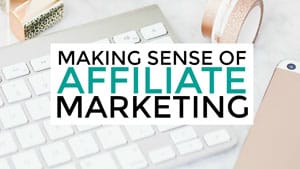
This is the ultimate Making Sense of Affiliate Marketing review.
We recently spent 20+ hours reviewing the premium training materials for Michelle Schroeder-Gardner’s popular affiliate marketing course.
If you want to know:
Then you’ve come to the right place.
Let’s get started.
Hey, I’m Niall Doherty.
I quit my last 9-to-5 job back in 2010.
Since then, I’ve earned my living online in various ways. Revenue for my latest business is at $1+ million and counting.
I’m on a mission to accurately rate and review all the best “make money online” courses. My team and I have spent 1000’s of hours investigating these courses and getting feedback from real students.
All that to say: we know a thing or two about such courses and making money online.
Intro
Praise
This review is a joint effort between Niall Doherty of eBiz Facts and Conor Monaghan of One Minute English.
Our process:
Note: We earn a commission if you decide to make a purchase through referral links in this review. Read our full disclosure here.
Michelle Schroeder-Gardner is an American blogger who regularly reports monthly earnings of $100,000 or more. She started her blog – Making Sense of Cents – in 2011 at the age of 22, and has since received numerous awards and recognitions for her work.
Here’s how Michelle describes herself on the Making Sense of Affiliate Marketing sales page:

Michelle publishes regular income reports on her blog – until Dec 2018 here and more recent here – and has reported significant earnings over the years:
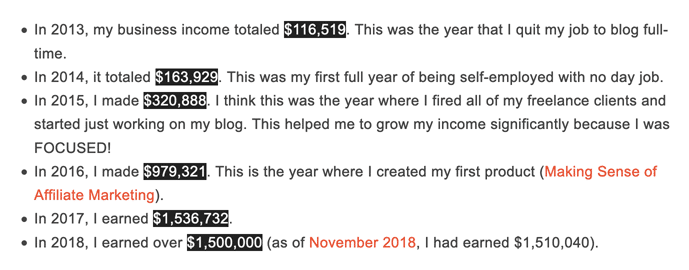
Since 2016, she has reported earning approximately $50,000 each month from affiliate marketing alone, and often much more…
Best I can piece it together from Michelle’s own income reports, her road to affiliate marketing success unfolded like this:
Making Sense of Affiliate Marketing is Michelle Schroeder-Gardner’s premium course that promises to help you earn affiliate income from your blog.
Here’s how the course is described on the sales page:

The course has proven very popular.
In February 2019, Michelle reported her earnings from sales of the course:
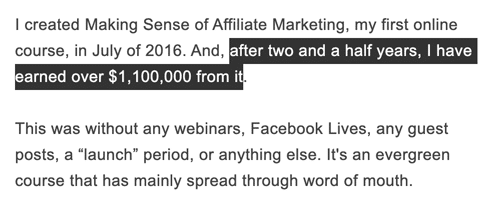
That works out to about $37k per month, which means an average of 6 people PER DAY sign up for Making Sense of Affiliate Marketing.
Since its launch in July 2016, Making Sense of Affiliate Marketing has been available for a one-time cost of $197, or two payments of $105 per month.
Those are the prices you’ll see on the sales page for the course. Both options give you lifetime access to the program, including future updates.
While doing research for this review, I noticed that many people also search for:
With that in mind, here is some additional info related to the price of the course:
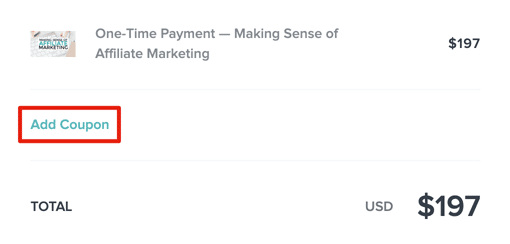
…so I did some searching, but wasn’t able to find a valid coupon ☹️
Michelle has apparently offered up to 20% off the course for a limited time in the past, but there doesn’t seem to be any regular or scheduled promotion. If you want to hear about future discounts, your best bet is to sign up to Michelle’s mailing list and wait for an announcement. (You’ll find a sign-up form on the Making Sense homepage.)
Making Sense of Affiliate Marketing is organized into 6 modules with 40+ lessons, and several bonuses. When you join, you also get access to a private Facebook group (more about that here).
You can see the full curriculum on the course sales page (about halfway down).
The course is hosted on the Teachable platform and looks like this once you’re logged in:
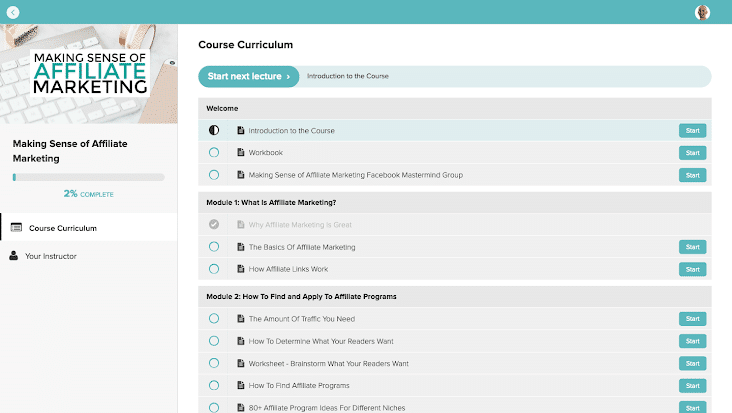
The layout is simple and easy to follow.
Unfortunately not. Making Sense of Affiliate Marketing is more a list of “things to keep in mind” than it is a practical instruction in affiliate marketing.
Here’s a quick overview of the biggest issues I found:
The course isn’t all bad – some positives listed below – but overall it fell well short of my expectations and does not compare favorably to some other courses I’ve reviewed…
Making Sense of Affiliate Marketing does offer a 30-day money-back guarantee. To receive it you must show “that you went through the course and took action.” I personally received a full refund without any trouble.
Here’s how the guarantee is described on the MSoAM sales page:

I’m not a big fan of such “conditional” refund policies, but I have heard from at least one person who bought the course that she received a refund with no trouble, and I also received a full refund upon request…
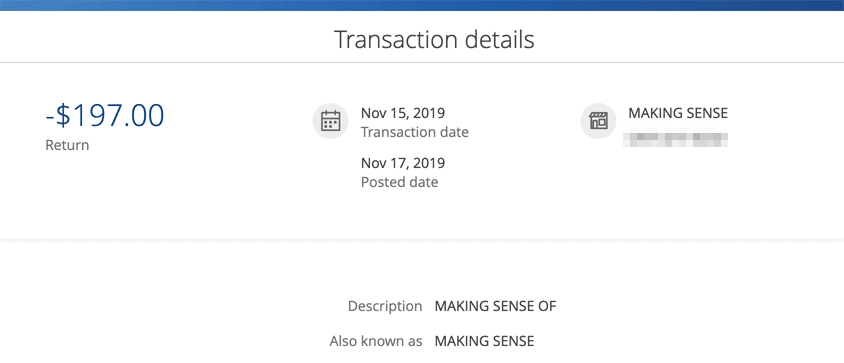
To request the refund I simply emailed [email protected].
I sent along a first draft of this review in the same email, and wouldn’t have been surprised if Michelle had refused my request after reading all this. But, to her credit, she put through the refund right away.
There isn’t a lot to like in the course, but let’s start with some positives regardless.
(or click here to skip ahead to the criticism)
The best part of Making Sense of Affiliate Marketing is the private Facebook group. You’ll find lots of aspiring affiliate marketers active in there, as well as quick responses and frequent posts from Michelle.
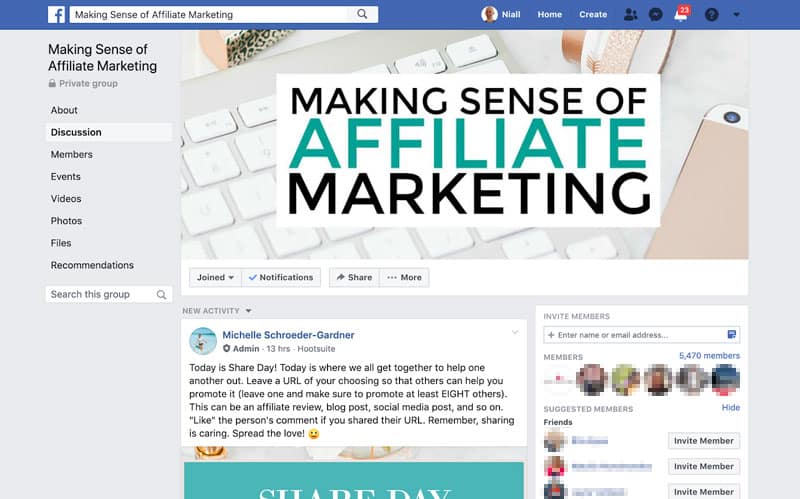
Once you join the course, you must send a request to join the Facebook group and wait to be approved. (I was approved within 24 hours.)
Stats for the group when I joined:
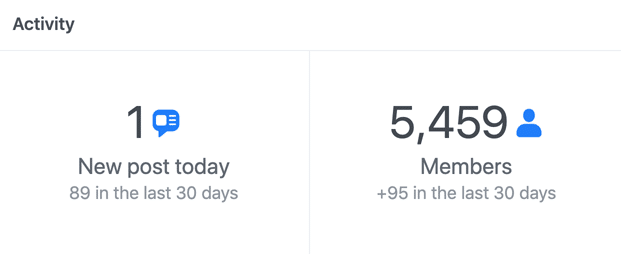
That works out to about 3 new members and 3 new posts every day.
Most posts receive responses within a few hours, and often a response from Michelle herself.
Examples:
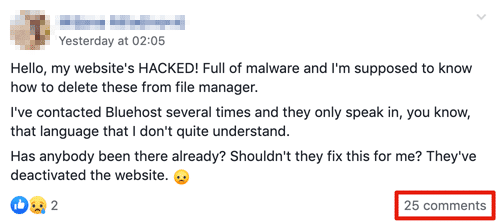

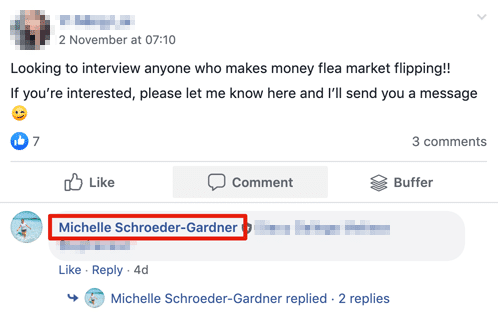
Michelle seems to regularly take time to interact with members of the group, check out their sites, and offer specific feedback.
Example:
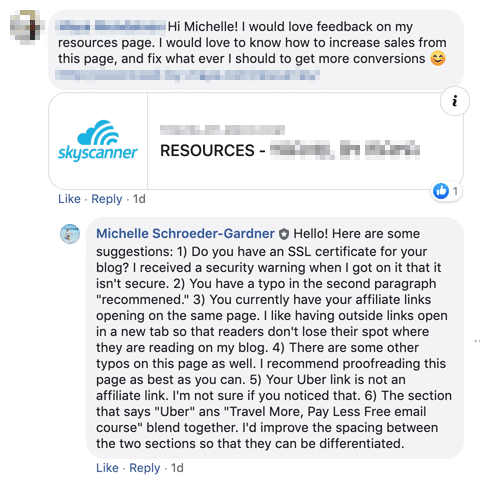
However, the group does fall short in a couple of ways:
So while the Facebook group is probably the best thing about Making Sense of Affiliate Marketing, I see it mainly as a place to connect with other newbie affiliate marketers, and not a great source of affiliate marketing help and info.
You won’t find any grey or black-hat marketing tactics or strategies inside Making Sense of Affiliate Marketing. Michelle repeatedly recommends an honest and ethical approach.
Examples:



Also covered in the course are topics like:
All told, it’s clear that Michelle is eager to help her students stay out of trouble and avoid shady marketing practices.
Which is something that CAN’T be said for affiliate marketing courses like Wealthy Affiliate and ClickBank University (reviewed here and here).
Unlike some other affiliate marketing courses, there is no recurring payment for Making Sense of Affiliate Marketing. After paying for the training up front, you get lifetime access to all the course materials, the private community, and future updates.
Of course, the training is disappointing, the private community ain’t great, and there have been very few updates to the course since 2016 🤔
Moving swiftly along…
Some of the lessons inside Making Sense of Affiliate Marketing are worth your time, especially if you’re new to affiliate marketing.
Interestingly, the two lessons in the course I consider the best were not taught by Michelle at all.
They were bonus lessons from guest trainers…
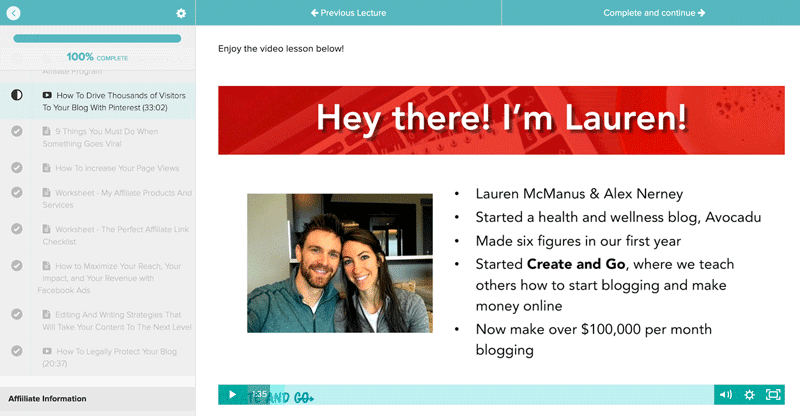

I thought those lessons were the best mainly because the trainers showed real, visual examples of what they were talking about, and the video format was much more engaging the the usual “wall of text” lessons in the course (more about that below).
Generally speaking, if you’re an established blogger but brand new to affiliate marketing, you’ll learn a few things from the MSoAM course.
But you’d be far better off investing in an alternative course from the top of our list…
Making Sense of Affiliate Marketing claims to be “the step-by-step affiliate marketing strategy course,” but the material lacks depth and specifics. You can find better training on pretty much every topic the course covers freely available on the web.
Perhaps the best example of this is Michelle’s lesson entitled, “Teaching With Tutorials.”
I was excited for this lesson, after seeing it described like so on the MSoAM sales page:

Unfortunately, the lesson turned out to be only 612 words long, with no screenshots…

And as you can see, the “exact steps” at the core of that lesson are incredibly generic…
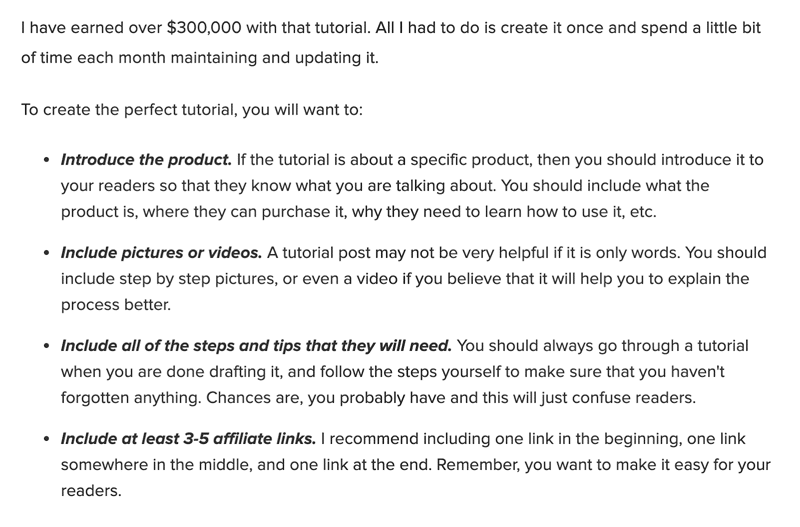
Seriously, those were the steps.
Good luck turning that advice into $300, let alone $300,000.
Michelle’s lesson on creating reviews isn’t much better, amounting to 1182 words and four screenshots.

I couldn’t help but compare that to the multiple lessons on the same topic in a course called The Authority Site System …
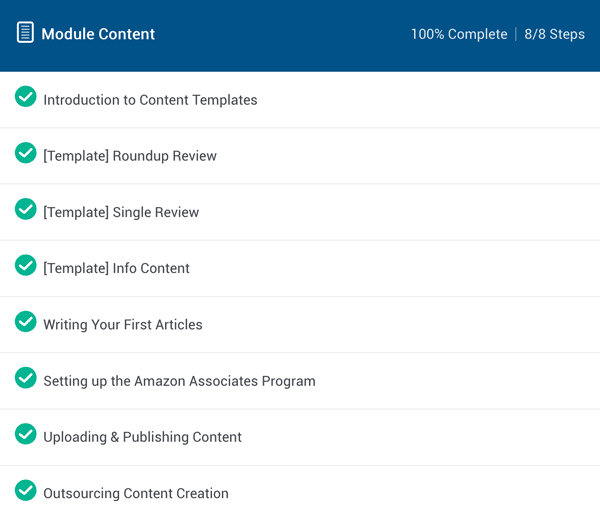
That training amounts to approximately 3.5 HOURS of detailed, over-the-shoulder video instruction, and comes complete with handy templates you can use. 4
Meanwhile, Michelle covers the same topic in a 1200-word blog post 😕
Here’s another example of shallow and generic advice within MSoAM:
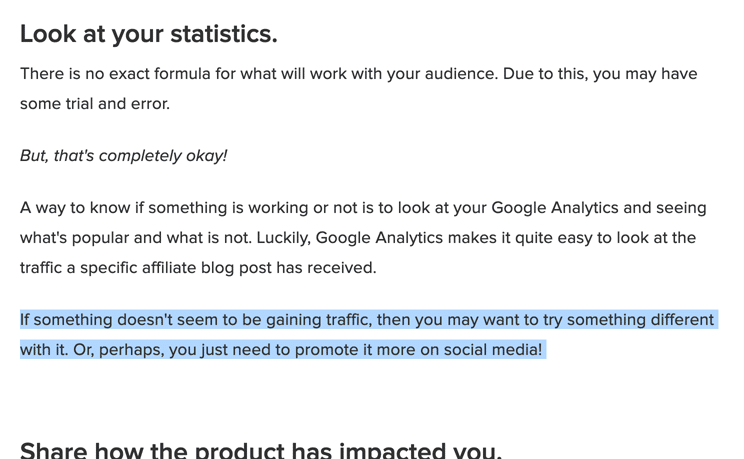
What struck me while going through the course is that, for almost every topic covered, you can quite easily find much BETTER and more UP-TO-DATE training freely available online.
For example, take this lesson:
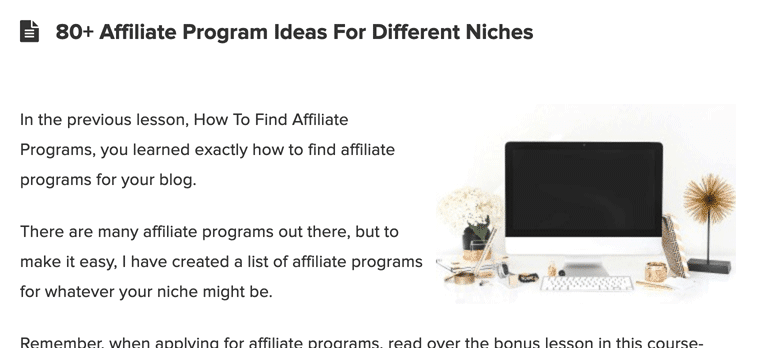
Each of these articles I found via a quick search are superior to that lesson:
I dare say the same is true for every lesson inside Making Sense of Affiliate Marketing.
And sure, MSoAM at least has all the info organized for you in one place.
But my faith in the training became so low as I went through the lessons, that I regularly found myself jumping over to Google to find more in-depth and up-to-date info.
And almost always, I found it.
Throughout Making Sense of Affiliate Marketing, you’ll see many claims and recommendations, but very few citations or detailed instructions.
For example, you’re told to evaluate the management of each affiliate program you’re considering, but never shown how to actually do that…

Michelle tells you that interviews are a great way to promote affiliate products, but doesn’t show any data or examples to back that up…

You’re told to “grow your email list” and “track how you’re doing,” but never given any specific instructions or walk-throughs showing you how to do that…
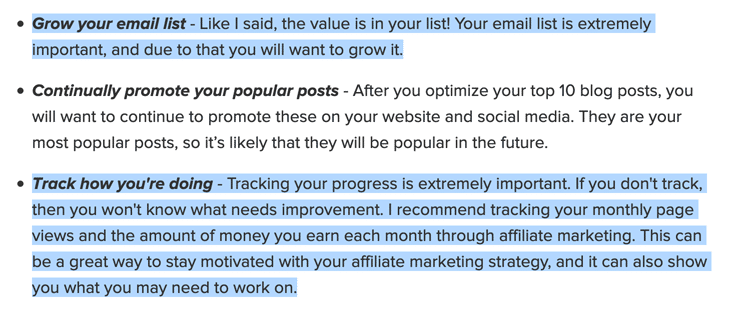
You’re told it’s important to “be an expert,” but this is the extent of the “instruction” you’re given on how to do that…
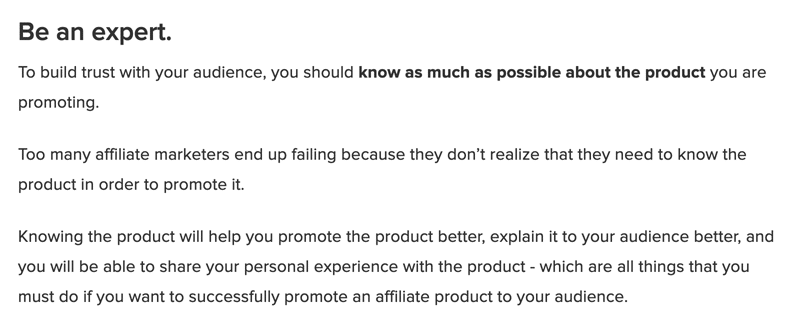
You’re told that some strategies on social media don’t work very well, but not given any examples or screenshots of such strategies, or shown any data…

You’re told about “an important number to calculate,” but never shown how to actually find the data required to calculate it…

You’re told it’s a good idea to create “a help sheet,” but never shown what such a sheet looks like, or what it should contain exactly…
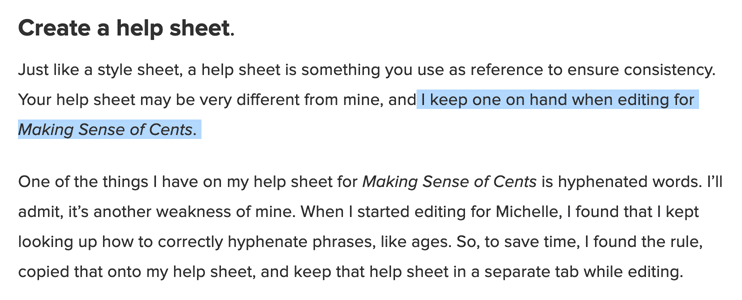
You’ll find many more examples of TELLING but not SHOWING throughout the course.
Learning affiliate marketing this way is like learning how to fly a plane by reading 100 pages of text with a dozen photos sprinkled in.
And instructions like this:
Remember to always lower the landing gear as you approach the runway.
But I’m not going to tell you where to find the switch for the landing gear.
Nah, that’s not important.
In contrast to every other affiliate marketing course I’ve seen, Making Sense of Affiliate Marketing completely ignores SEO and offers no training on the topic at all.
This is incredible to me.
For reasons best summed up by these three findings of a 2019 study of 3.25 billion site visits:

So that study basically says that most website traffic comes from organic search, regardless of niche.
Given that, you’d think Search Engine Optimization (SEO) would be a key thing to cover in a course about affiliate marketing 🤔
But these are literally the ONLY two mentions of SEO I found inside Making Sense of Affiliate Marketing:


To summarize:
The reason for this massive oversight would seem to be that Michelle has never relied much on organic traffic to her own site, which she readily admits:

In that same article from September 2019, Michelle reported her traffic numbers:

Ahrefs estimates that only about 20% of that traffic comes from organic search:
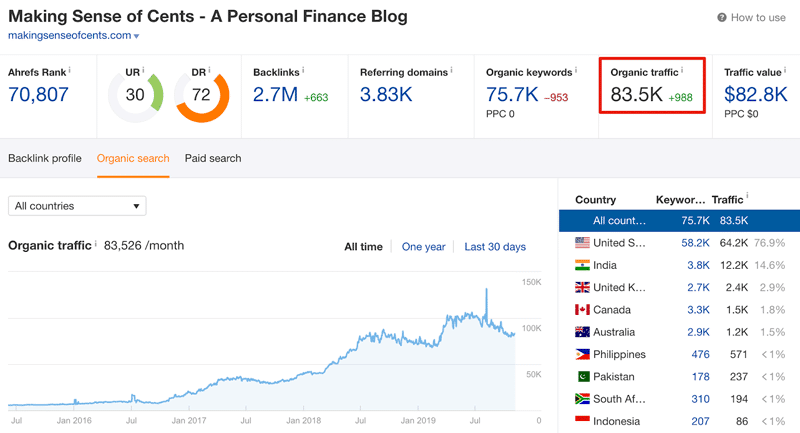
While Alexa.com puts the estimate at closer to 30%:
Either way, that’s unusual.
Most blogs get the majority of their traffic from SEO. But Michelle’s seems to get most of its traffic from social media, particularly Pinterest…
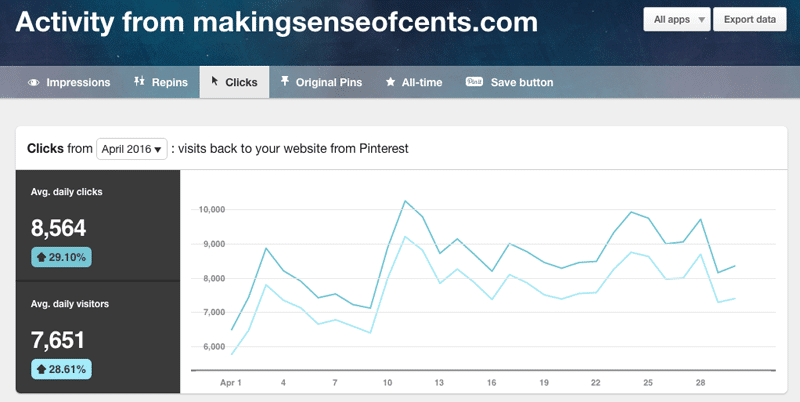
Which perhaps helps explain why there are two lessons about Pinterest inside Making Sense of Affiliate Marketing.
Still, the fact that Michelle herself doesn’t seem to have much experience with SEO shouldn’t excuse the complete lack of SEO training in the course. Not when SEO is such a key part of affiliate marketing.
I’m left wondering why she didn’t just bring in an expert to teach a few SEO lessons in the course, like she did with the lesson about Facebook Ads 🤷♂️
Michelle’s comment after reading this review:
Most of my traffic does not come from Pinterest. That used to be the case, but now it’s only around 10%.
Two things stand out about Michelle’s path to affiliate success. The first strikes me as a big advantage most aspiring affiliate marketers never have, while the second makes me wonder how Michelle would fare starting a new site from scratch.
First:
Michelle was consistently earning about $10k per month online and had built up a big audience BEFORE she started focusing on affiliate marketing.
Here she is in December 2014 noting that her site was already receiving around 100,000 page views per month…
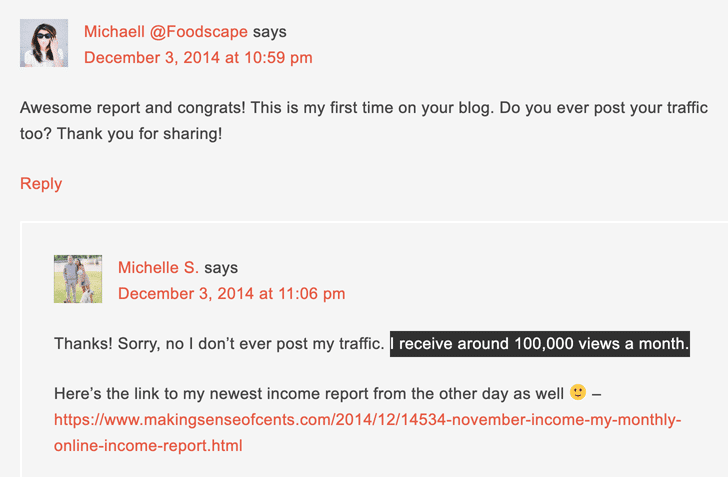
I went through her income reports for the six months PRIOR to that comment (Jun-Nov 2014) and calculated her earnings:
Given that, the “formula” for Michelle’s success would appear to be as follows:
There’s certainly nothing wrong with that approach – and fair play to Michelle for pulling it off – but I see it as an approach very few people can emulate.
It essentially boils down to this:
Second:
As far as I can tell, Michelle has only ever earned significant affiliate income from one website: makingsenseofcents.com.
In contrast, the creators of courses like Authority Hacker’s TASS and Income School’s Project 24 – reviewed here and here – have built and earned significant affiliate income from MULTIPLE websites.
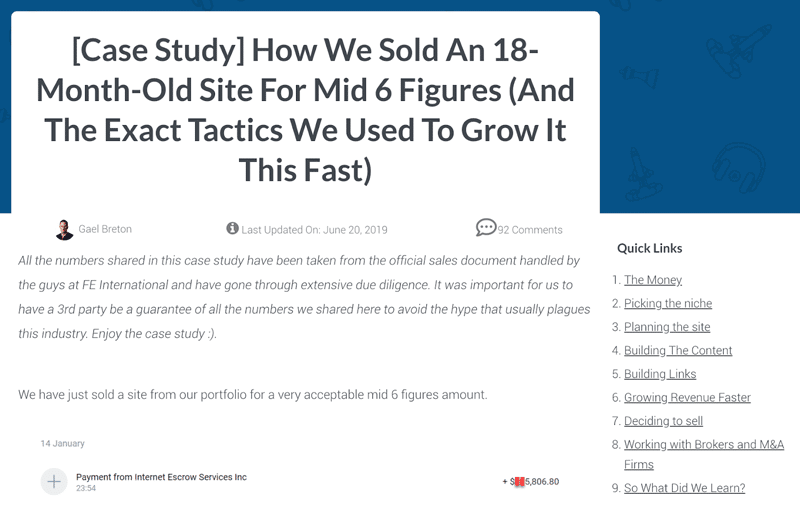
Not to take anything away from Michelle’s success as an affiliate marketer: she’s clearly worked hard and smart to build her audience and her income, and has been at the top of her game for several years.
But successfully EARNING affiliate income and successfully TEACHING affiliate marketing are two very different things!
Personally, I’m wary of learning from someone whose success is limited to a single site.
Especially when that site had 100k visitors per month before it ever earned significant affiliate income.
Michelle’s comment after reading this review:
I don’t think my path was unusual, and I also do not think it’s odd that I only have one website. I like affiliate marketing because it can make my blog more passive, and I like a more personal blog that I can focus on better. That being said, I have had other websites that I have sold in the past so that I could just focus on Making Sense of Cents.
The reason why I waited to earn affiliate income is something I often talk about. I didn’t start my blog to make money blogging, so I didn’t even know what it was.
Most online courses these days make heavy use of video to teach the material. But the lessons inside Making Sense of Affiliate Marketing are mostly text, usually to their detriment.
Here’s a prime example:
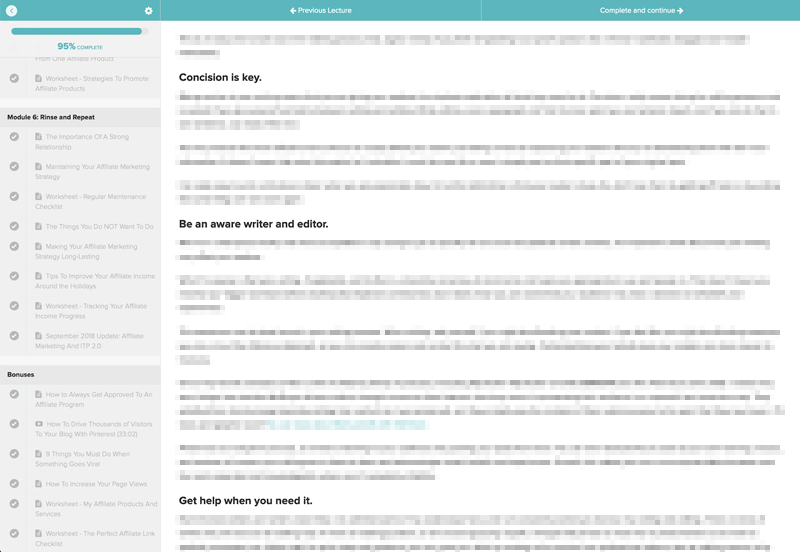
Another:
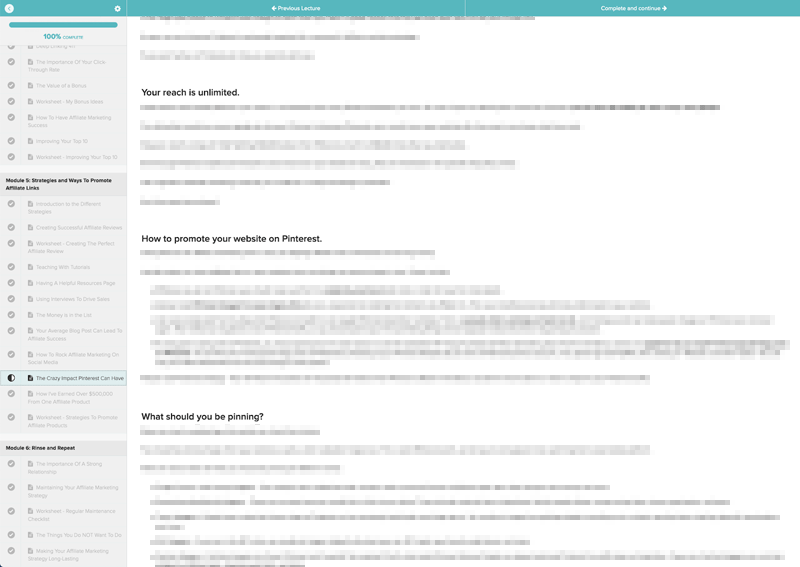
Most of the lessons are like that: walls of bland text, with only the occasional screenshot to break up the monotony.
Of course, not every topic would be better addressed in video format, but several undoubtedly would.
Such as:
As it is, you’ll find only three video lessons inside Making Sense of Affiliate Marketing, and none of them are from Michelle ☹️
Michelle’s comment after reading this review:
For me, I enjoy text courses more than videos, and that’s why I decided to make a text-based course. This is stated on the sales page, so that everyone is aware before purchasing. I have received many emails from readers who have thanked me for offering a text-based course, so I am glad that I did it.
There isn’t any mention of additional costs on the Making Sense of Affiliate Marketing sales page. But once inside you’ll see a number of recommendations for paid products and services.
Such as ConvertKit:

Tailwind:

And Facebook ads:

That last one had me scratching my head, because later in the course guest trainer and Facebook Ads expert Monica Louie tells you explicitly NOT to boost Facebook posts…
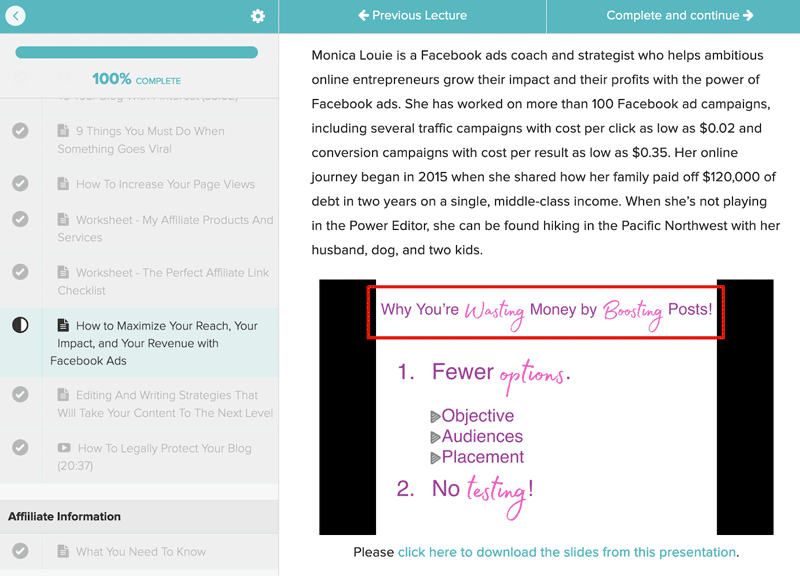
But I digress.
Here’s what troubles me about the recommendations of paid products and services within Making Sense of Affiliate Marketing:
For example, there are tons of alternatives to ConvertKit. (We’ve listed several here, with price comparisons.)
A notable alternative is Mailchimp, which offers a free plan that lets you email up to 2000 subscribers.
Surely that would be worth mentioning to new bloggers who want to test the waters with email marketing? (I stand corrected on this. See below.)
But that example pales in comparison to this one:
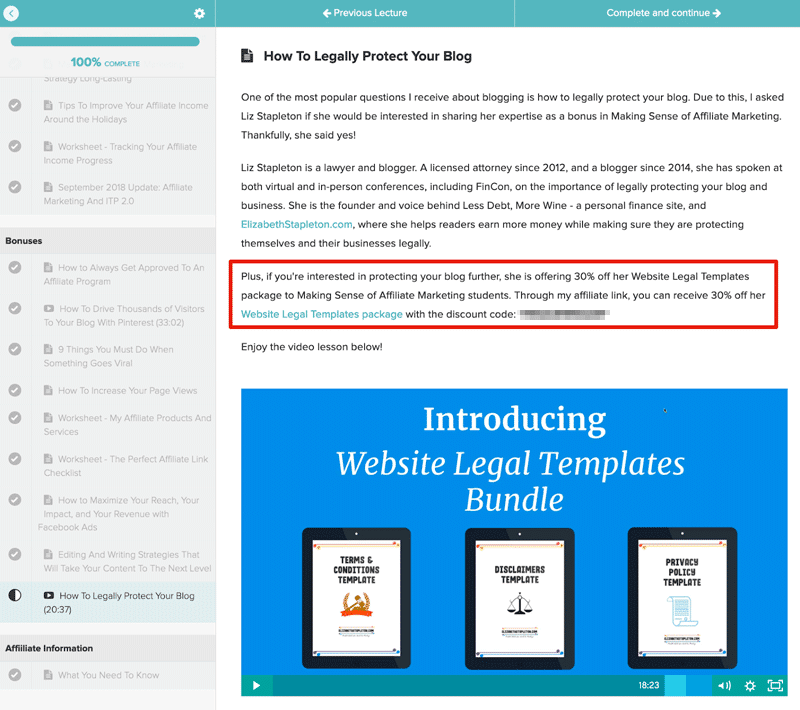
In that lesson – which is really just a short webinar that turns into a sales pitch – it is recommended that you buy a bundle of “website legal templates” that’ll cost you more than $100, even with the discount code.
Now I’m no expert when it comes to the legal stuff, but this struck me as odd since I’ve never seen anyone else – in any of the other affiliate marketing courses I’ve reviewed – suggest that you should pay for such templates.
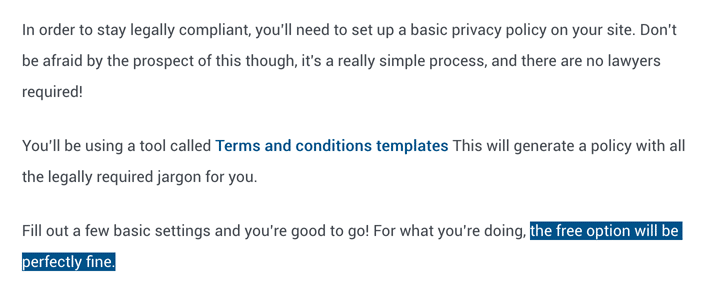

With that and the ConvertKit example, I have to agree with another student of Making Sense of Affiliate Marketing, who messaged me the following:
“Michelle really lies in a grey area of promoting what will make her money first and then if that helps the reader all well and good.”
Michelle’s comment after reading this review:
I disagree with the hidden costs section. You don’t need to do Facebook ads, and Tailwind and Convertkit can be done without it. I’m not a fan of Mailchimp because of their personal finance clause in their terms & conditions. I do talk about other free options, but that was through email. I need to add that to the course. The amount of things that a blogger could spend money on is endless, or it could be nonexistent.
For the website legal templates, I don’t always recommend bloggers get a free one. I do have a legal background, though, in my previous career, so I am more careful in that area when it comes to helping people who are not familiar with the legalities of running a business.
I asked Michelle to elaborate on Mailchimp’s “personal finance clause,” and she referred me to Mailchimp’s Acceptable Use Policy, which does indeed list “affiliate marketing” as prohibited content.
A fair point then that affiliate marketers should NOT use Mailchimp.
However, it’s worth noting that ConvertKit’s Acceptable Use Policy also has some restrictions on affiliate marketing, including a prohibition on “CPA affiliate type sites or similar affiliate type of sites, network marketing sites, affiliate educational offers, insurance sales or promotions.”
From my quick research, it seems most email marketing providers have something like this in their terms of use, but you should be fine so long as you’re not spamming people relentlessly with affiliate offers.
To summarize: Michelle’s reasoning for avoiding Mailchimp checks out. Best not use it for affiliate marketing.
Making Sense of Affiliate Marketing promises to help you, “whether you are a brand new blogger or if you’ve been blogging for years.” Unfortunately, the course isn’t very helpful for anyone, but especially not for newbies.
You’ll find the following in the FAQ’s section of the MSoAM sales page:

I found this to be a very misleading claim, given that:
In fact, the whole course seems to assume that you already have an established blog with a decent amount of traffic, but you’re not sure how to monetize it.
Which makes sense, because that’s the situation Michelle was in back in late-2014: she’d been blogging for 3+ years by then, and her site was getting 100,000 visitors per month.
But she didn’t know much about affiliate marketing, and wasn’t even earning $1000/month as an affiliate.
If you’re in a similar situation, Michelle’s course might give you a few helpful tidbits.
But “a great learning tool” it certainly is NOT, regardless of whether you’re a new or experienced blogger.
Making Sense of Affiliate Marketing is littered with PDF “worksheets” and bonus “lessons.” Aside from the content of the PDFs being mediocre (at best), the format will have you scratching your head.
For example, I’m still trying to figure out why on earth this worksheet from the course is offered as a PDF:
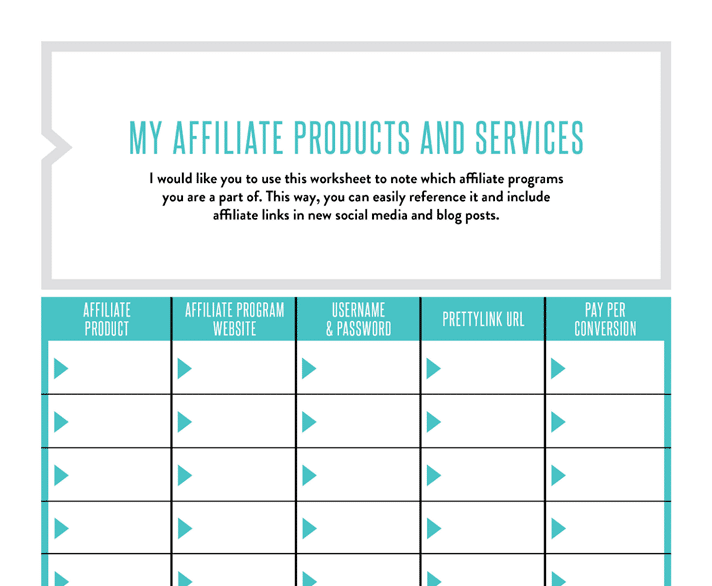
To be clear: that PDF is NOT one of those editable PDFs that you can download and start typing into.
No: apparently you’re supposed to download it, print it out, prepare your ink and feather quill, and actually handwrite usernames, passwords, and URLs onto the paper.
Here’s another one:

Some of the PDFs ask you to handwrite whole paragraphs, for no particular reason:

For the life of me, I can’t figure out why these “worksheets” aren’t offered as simple Google Docs or Google Sheets that students can easily copy and then edit themselves.
That’s what you see in other affiliate marketing courses, like The Authority Site System…

Some of the “bonuses” inside Making Sense of Affiliate Marketing are also offered as PDFs, for no apparent reason.
Like this one:
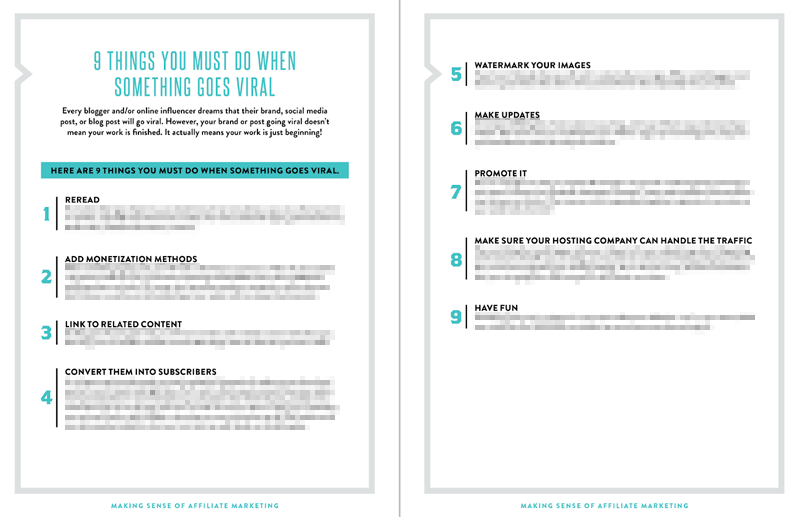
And this one:
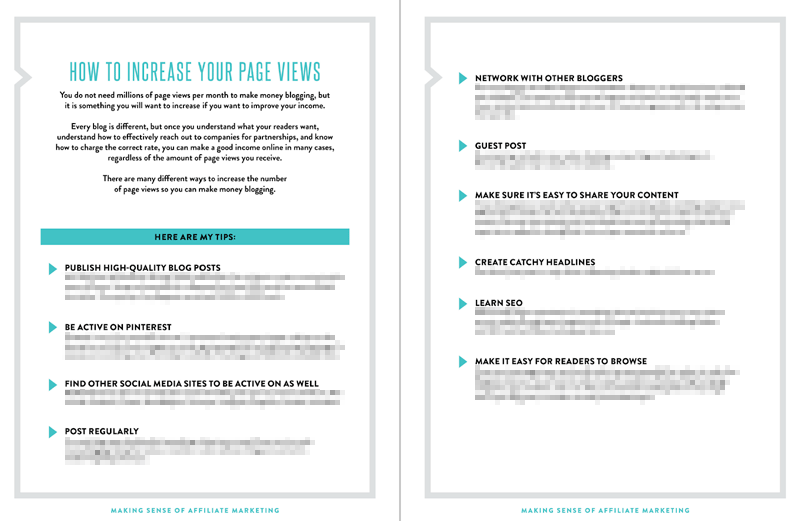
I’m not sure why those “lessons” aren’t offered as regular web pages, like the rest of the course materials.
My best guess is that putting such thin content in a PDF makes it seem a bit more substantial.
Michelle’s comment after reading this review:
Many students like the printables, and yes, they print them out. I have received numerous pictures from students who have printed everything out and handwritten everything in, and enjoy it.
Making Sense of Affiliate Marketing comes with several “great bonuses,” but most of the bonuses are incredibly disappointing.
Here’s how one bonus is described on the sales page:
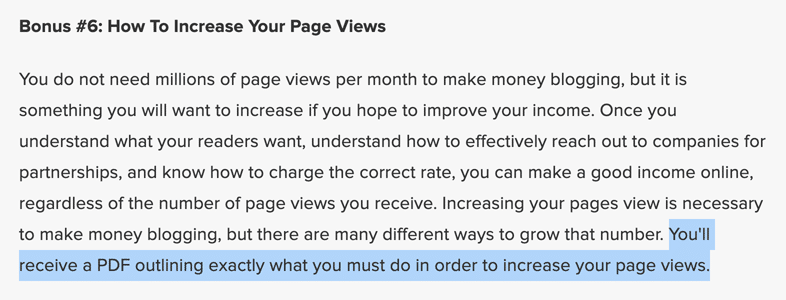
I don’t know about you, but when I’m told a PDF will outline EXACTLY what I must do to increase my page views, I expect more than 2 pages of info…

…and empty tips like these…


(For the record, I didn’t see ANY additional info on guest posting or creating headlines within the course. Those brief mentions are as good as it gets.)
Here’s a list of the other eight bonus lessons inside Making Sense of Affiliate Marketing, with my notes for each:

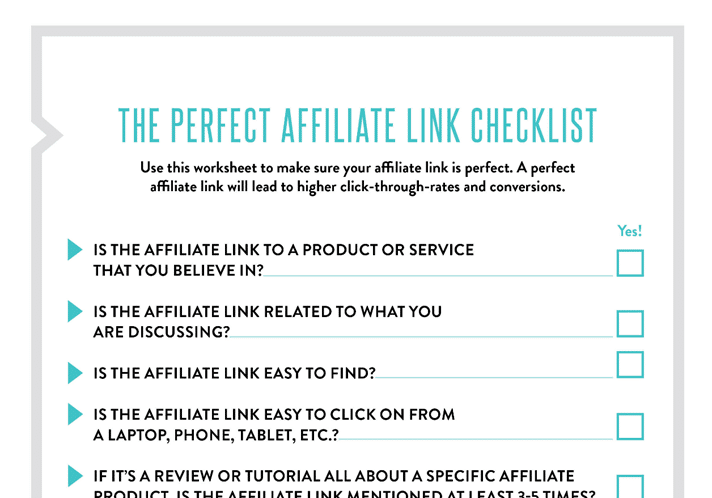

Out of those 9 bonus lessons, I’d say only four of them are decent – not great, but decent – and the rest are a waste of time.
If I’m not careful, this review will end up being longer than Michelle’s entire course. So let’s quickly rip through a few other things that bugged me about Making Sense of Affiliate Marketing…
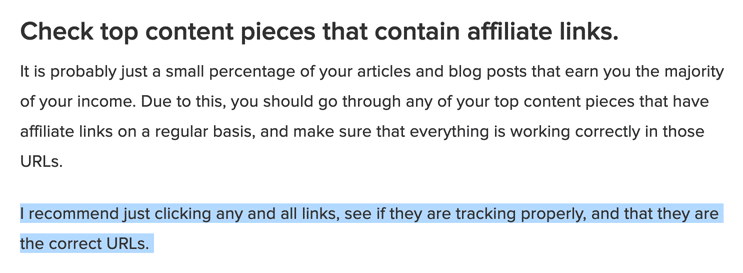

And yet Michelle still recommends promoting affiliate products on Instagram, without offering any data or reasoning to show that it’s actually worthwhile:
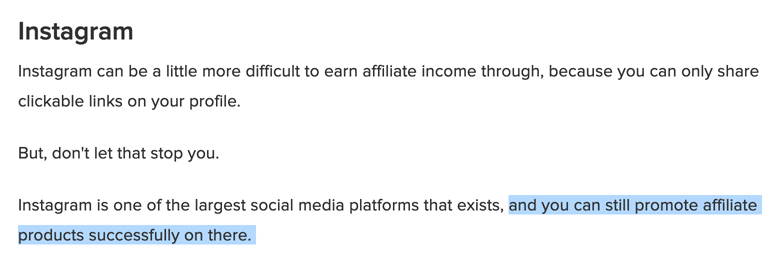
Michelle’s comment after reading this review:
Instagram can actually be quite good for driving traffic, and is wonderful for engagement.
Engagement, probably. But I’ve still never seen any data to support the claim that Instagram is good for driving traffic. And if you can’t drive traffic, you’re kinda screwed as an affiliate marketer.
(If you know of any Instagram data or studies that show it’s good for driving traffic, let me know in the comments below.)
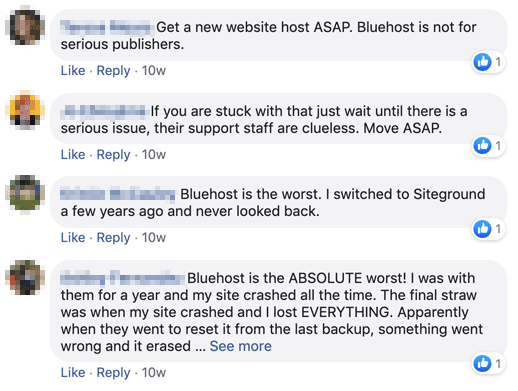

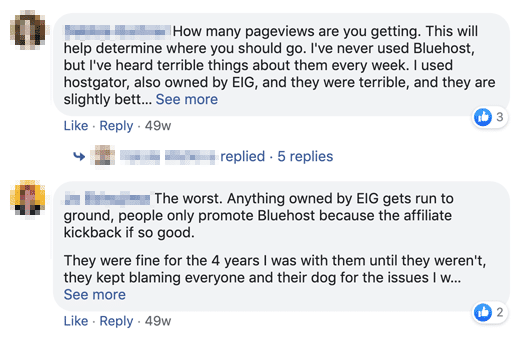

I’ve personally reviewed Swagbucks in-depth, and implying that you can earn $500 on there is nothing short of ridiculous. Our testing showed that you can only earn about $1 per hour on Swagbucks, so reaching $500 would take you three months of mind-numbing 40-hour workweeks.
A skeptic might say that Michelle recommends sites like Swagbucks NOT because they help her readers earn money, but because they help HER earn money…
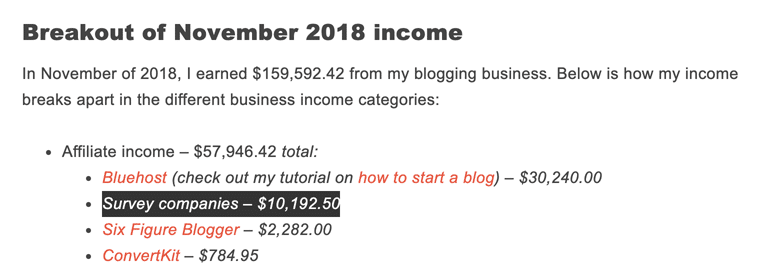
(To be clear: it’s totally cool to be an affiliate for sites like Swagbucks – I’m an affiliate for them myself – but it’s not cool to post misleading information about how much money people can expect to earn from those sites.)
As noted previously, about 6 people per day sign up for Making Sense of Affiliate Marketing. Given that, there is a strange lack of student success stories.
As of this writing, there are a total of eight testimonials on the course sales page.
The first three are hugely impressive, like this one…

The fourth speaks to a small, quick win…

And the rest don’t reveal any specific results achieved, instead just offering general praise for Michelle and the course.
Example:

It’s also worth noting that the first testimonial above is from 2017, and the lady who wrote it seems to credit her blogging success to a different course elsewhere:
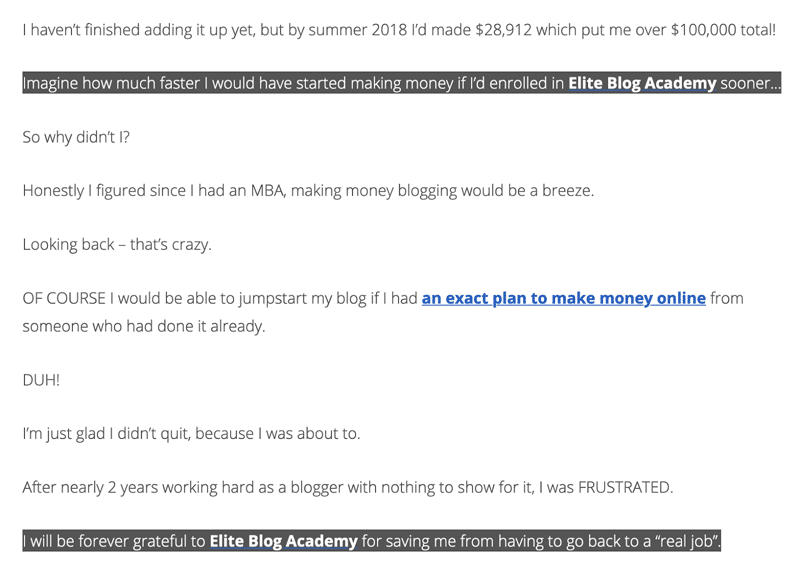
But perhaps more telling are the student comments in the weekly “Winning Wednesday” posts within the MSoAM Facebook group…
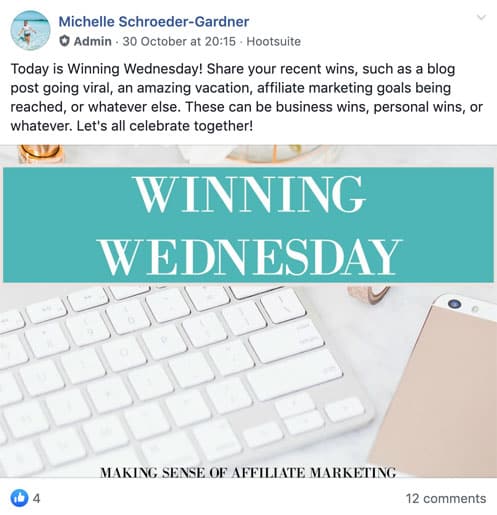
I went through 6 weeks of those posts, and found comments like these:
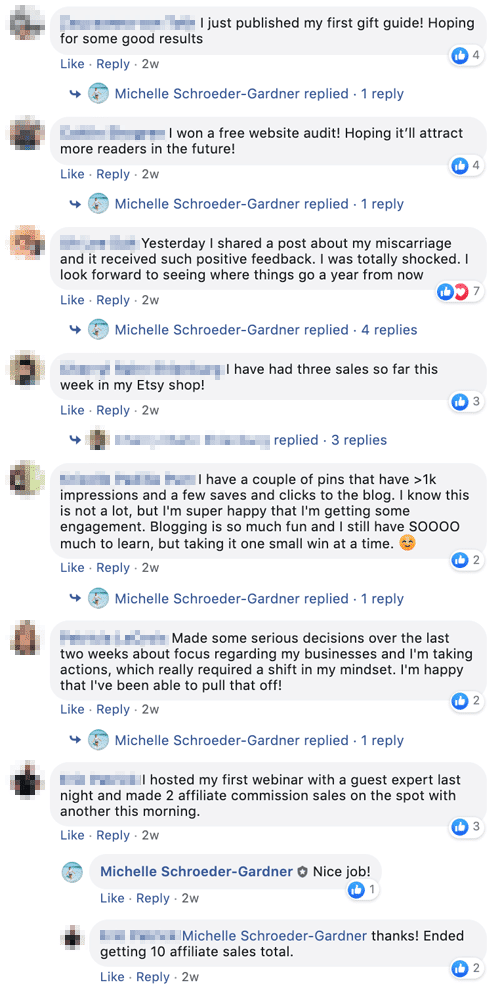
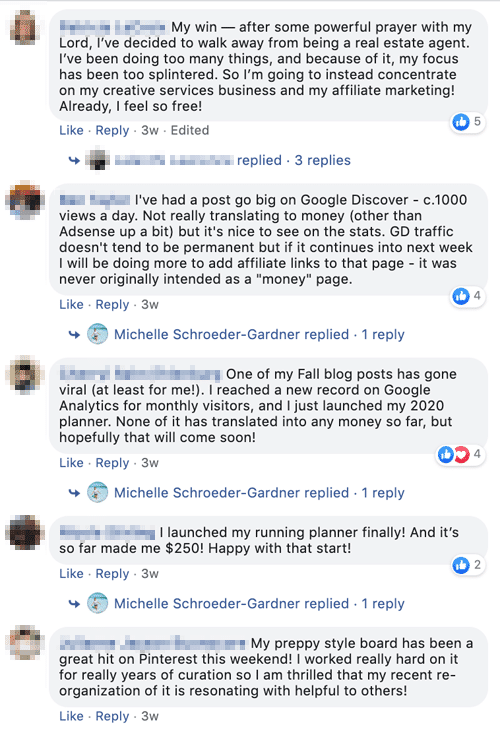
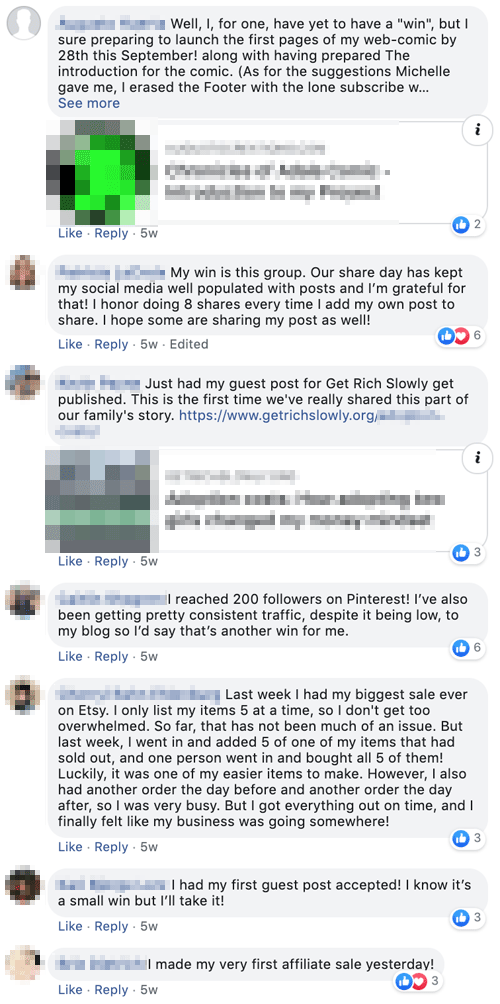
I counted 30 top-level comments from those 6 weeks, and found that only 3 reported significant income earned from affiliate marketing.
Maybe it’s just me, but I would have expected to see far more wins being posted, given that ~250 new people join the course every 6 weeks 😕
That said, given my impression of the course, I also would have expected to see far more CRITICISM of Making Sense of Affiliate Marketing online.
But that’s not the case, either.
While there are some lukewarm reviews to be found, this comment on Reddit is about as critical as it gets:
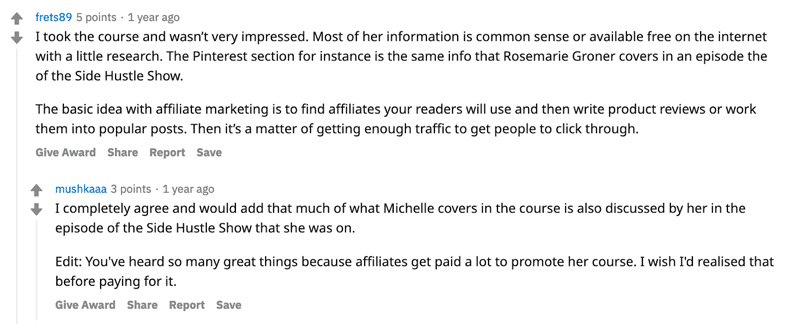
Here’s what’s weird though:
Perhaps the explanation is that Michelle herself is very likeable, and few people are willing to criticize her course for fear of blowback from her fans.
Or perhaps Michelle’s own success as an affiliate marketer is so massive that people assume they themselves are at fault when her training doesn’t work for them, and so are disinclined to ask for a refund.
What do you think?
Let me know in the comments below.
I can’t in good conscience recommend anyone sign up for Making Sense of Affiliate Marketing.
Not when there are a number of better alternatives available (see below).
There are some decent teachings and ideas within the course, but nothing is covered in-depth, there are significant gaps in the material, and you can easily find better training freely available online for 90% of the topics covered.
Here’s how my co-reviewer summarized his impressions of the course:
“Compared to Income School and TASS [reviewed here and here] this course just does not cut it for me. Too much stuff left out, too much theory, and not enough practical examples.
I would give it 2 stars as it does give you some examples due to Michelle’s experience of running a successful blog. But key info like keyword research, actually writing the content, SEO/backlinks are all missing.
A series of blog posts or a book would be a more suitable medium.”
To piggyback on that last point, I believe Making Sense of Affiliate Marketing would be much better presented as a $10 ebook or Udemy course.
In those formats the training would still be fairly useless, but at least it wouldn’t be massively overpriced.
We’re on a mission to find the best “make money online” course, based on real student feedback and our extensive research.
Here’s our top 5…
The course had its merits.
It provided a solid foundation, especially for beginners. The content was well-organized, and the lessons were easy to follow.
But here’s the catch, it was too generic. The strategies they taught were broad and didn’t align with the specific niche I was targeting.
I quickly realized that success in this field requires more than just following a set of formula. It demands adaptability, creativity, and a deep understanding of your audience.
I’ve been working online full-time for about 13 years and I took this course to up my game in affiliate marketing. The course is so basic that it won’t even help beginners.
The person that created the course seems to have just gotten lucky with their affiliate marketing success. None of the tools and techniques listed here will drive your growth. I have WAY more experience than this person and it’s a shame that beginners won’t realize that they aren’t learning anything helpful.
They sent me an email asking for feedback. I told them what I said above. I received a refund immediately and they kicked me out of the Facebook community even faster.
I own a blog that’s done very well for years, and when I decided to take the affiliate part of my site more seriously, I bought the course.
I knew Michelle and a few other bloggers who recommended her course so I felt safe in the purchase. However, after going through it, I realized that all of the things she taught were tips I could have found on Google.
I looked for the tips I thought she would share; the kind that was giving her the $50k+/mo through affiliate marketing. But nothing. And I don’t think it’s because they just simply don’t exist and that she just happened to do the normal affiliate steps better than others.
It’s either one of two things:
1. She’s better at doing than teaching. Some people just aren’t good teachers, and remembering to include all of the tips that got them to where they are.
2. She’s not willing to share everything she did so the competition with affiliate marketing will be lower.
I’d like to think it’s not the second option, but I sometimes wonder.
Now, it could just be the simple formula of finance niche + good/consistent traffic + trusting/loyal audience + social proof = more income in affiliates. Most likely that could be the case. Sadly, she doesn’t cover this (or parts of this formula) in her course and how to get there.
I feel like the course was just a way for her to create another revenue stream so she’s not completely dependent on traffic and affiliates. My impression is that it’s not to help others, which is very sad.
Lastly, I’d like to see what courses she took that helped her with affiliates and selling in general. When I look at the way she sells/promotes ANYTHING, I think she’s a pro and that she learned it somewhere. I don’t think it came naturally to her. Unfortunately, she doesn’t share that in blog posts and she doesn’t teach the BIG things she does to sell/promote in her course.
But that sums things up. Do not get this course.
I bought the Making Sense of Affiliate Marketing Course and it was interesting, to say the least.
In my opinion, it was an overall informative course. However, I didn’t like that it was all reading and no video or audio. I think it could be made better in those respects. Overall, the information was spot on.
As of right now, I have not been able to build a successful affiliate marketing business from it but I’m certainly working on it. I think in another year or so I will have a successful affiliate marketing business.
Thanks Niall, very useful. I’m always a little cautious of bloggers that make a decent income but started over 5 years ago. I think the landscape has changed a lot in recent years and what may have been good then, might not work in today’s market.
As a big fan of SEO, I know a course from 2016 wouldn’t be of much use now, so I wonder if affiliate marketing would be the same?
Hey Pete. Affiliate marketing has definitely evolved a lot since 2016. It is more competitive now; it’s rare to see crappy sites ranking well in Google for lots of good keywords nowadays. So you have to bring your A-game and commit for the long haul if you want to be successful at it.
Same for other ways of making money online like Amazon FBA. It used to be easier simply because standards were lower and there was less competition.
At the same time, if you can become one of the best in your niche, the rewards seem to be larger than ever now, as there are more and better ways to monetize and more people constantly coming online.
Thank you Niall for this very thorough review. I’ve been eyeing this course for awhile and thought it strange that the price never really increased since she rolled it out years ago. It seemed indicative of it’s value and your review confirmed that !
I haven’t bought this course, but I wanted to say THANK you for all these reviews. I have actually bought a course from a student of a couple of other people you mentioned in this review, and I quickly realized (but too late since I paid, and she had the exact same policy as Michelle about refunds) that I was experiencing a- what felt like- pyramid scheme. Let me explain: you buy a course from someone, their tactics dont really work as you wanted (or perhaps at all!) AND you spent way more on this due to the fact that they only show you how to install particular themes, buy convertkit, buy tailwind, and so many more, which they are affiliates. So what do you do after this, create a course about blogging/seo/pinterest yourself, and then you do the some…not only that, when I asked through email more specific about the technical site of things I got a reply of “you can find all these free information on internet…” So reading this review kind of felt like my experience. so again thank you for all the reviews you have thus far. very thorough, very honest very transparent.
Thanks, Natalie! Glad you’re finding the reviews helpful 🙂
Hello,
I bought the course in 2017-2018 (I think) and it had not worked for me. I had not made any sale at all and I’d mentioned in the group. I haven’t got any help. It was terrible. I left the group. My money badly spent. I regret buying the course.
Hi there
Thanks so much for leaving an honest to the point of being a painful review of MsoaM.As someone who bought the course after reading positive reviews online, I felt like kicking myself for believing the reviews.
What a joke for a course, what a shameless way to collect $197 from desperate people trying to succeed in affiliate marketing.
I`m no expert and I do not make 4 figures affiliate income every month, but I felt, I could have written a better eBook to be sold for $20(apart from my English skills) and still offered better value than what I got from MsoaM.
Now to the positive reviews, I read before buying MsoaM, after spending more time online, I`ve come to learn of something known to me as(female bloggers are a tight community). Products are offered exchanged for positive reviews.
I recognize two faces above, and I can always guess what products they are reviewing or promoting. But look closely, somewhere along the way, you`ll find the product they reviewed is from a mommy blogger and sooner or later, that mommy blogger will mention them or their product (in return as a favor? I don`t know).
I used to fall for these kinds of reviews but not anymore.
Opt into their list and you`ll understand how they work A will promote B today and C will promote A and D will promote B.So I went ahead opted in during some combined course and that`s how I came to see the pattern.
So in the end, it`s positive reviews from some below-average course that any beginner could find with a simple google search, and the free google search will most likely turn out more useful.
Once more thanks for a thorough review, even as someone who bought the course and felt seriously disappointed. I could not have done a better job at reviewing this course.
I`ll be ashamed of myself if I created such a shallow course and tried to sell it even for $50 because……….I`ll be reaping people off.
Having gone through the course (some of it as it was not worth my time) the max I`ll pay for it will be………$30 and that`s strictly because of the bonuses.
Ok it’s the middle of the night where I am, I just read the entire thing and I’m incredibly and forever grateful you wrote it! I’ve seen this course been promoted all around Pinterest and I was really considering buying it but thank the universe I found you first! Now I can finally sleep a bit better tonight. Thank youuuu
Glad you found it useful, Gabriell!
I won’t actually comment on Michelle’s course–but holy heck that was thorough.
It’s refreshingly well thought-out and put together. Kudos Niall!
Thanks, Pete!
Been keeping an eye on your site recently. Interesting stuff.
Excellent thorough review. Anyone considering affiliate market should read all of Niall’s reviews before purchasing any courses. I enjoy his straight talk and honest evaluations. I hope he has an impact on the course selling business by getting authors to upgrade their content and offer true value. Keep up the great work Niall!
Thanks, David!
Me too! Courses on platforms like Udemy are kept in check by crowd-sourced ratings and reviews, but these stand-alone courses can easily make themselves look way better and more up-to-date than they actually are. My goal with these reviews is to test the claims of such courses and try give a more objective view of them.
Excellent review, thank you very much. I wondered for ages why everyone is always praising this course like it’s a gift from heaven but then I heard you can get 40% affiliate from promoting it since then I’ve been trying to find an actual, honest review, and this was exactly what I wanted to know, so thanks again.
As a side note, was good to know about MailChimp not accepting affiliate marketing, I think one always needs to be pretty cautious with terms and conditions – for example I constantly see people promoting Amazon affiliates in their emails even though it’s prohibited by Amazon, not good especially if their income mainly depends on it!